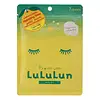What's inside
What's inside
 Key Ingredients
Key Ingredients

 Benefits
Benefits

 Concerns
Concerns

 Ingredients Side-by-side
Ingredients Side-by-side

Water
Skin ConditioningGlycerin
HumectantButylene Glycol
HumectantMaltitol
HumectantPyrus Cydonia Fruit Extract
Skin ConditioningC18-36 Acid Triglyceride
EmollientC12-18 Acid Triglyceride
EmollientJojoba Esters
EmollientSqualane
EmollientPhytosteryl Macadamiate
Skin ConditioningPhytosterols
Skin ConditioningTocopherol
AntioxidantPhytol
EmollientIsomalt
HumectantCeramide NP
Skin ConditioningCeramide Ng
Skin ConditioningCeramide AP
Skin ConditioningSodium Carboxymethyl Beta-Glucan
CleansingAcetyl Hexapeptide-8
HumectantLactic Acid
BufferingHydrogenated Lecithin
EmulsifyingMaltodextrin
AbsorbentCaprylyl Glycol
EmollientPolyglyceryl-10 Isostearate
Skin ConditioningXanthan Gum
EmulsifyingCitric Acid
BufferingSodium Citrate
BufferingPhenoxyethanol
PreservativeMethylparaben
PreservativeWater, Glycerin, Butylene Glycol, Maltitol, Pyrus Cydonia Fruit Extract, C18-36 Acid Triglyceride, C12-18 Acid Triglyceride, Jojoba Esters, Squalane, Phytosteryl Macadamiate, Phytosterols, Tocopherol, Phytol, Isomalt, Ceramide NP, Ceramide Ng, Ceramide AP, Sodium Carboxymethyl Beta-Glucan, Acetyl Hexapeptide-8, Lactic Acid, Hydrogenated Lecithin, Maltodextrin, Caprylyl Glycol, Polyglyceryl-10 Isostearate, Xanthan Gum, Citric Acid, Sodium Citrate, Phenoxyethanol, Methylparaben
Water
Skin ConditioningGlycerin
HumectantButylene Glycol
HumectantMaltitol
HumectantGlycosyl Trehalose
Emulsion StabilisingHydrogenated Starch Hydrolysate
HumectantCitrus Junos Fruit Extract
Skin ConditioningCitrus Unshiu Peel Extract
MaskingAscorbyl Glucoside
AntioxidantCitrus Junos Peel Oil
AstringentCitrus Aurantium Dulcis Peel Oil
MaskingRosmarinus Officinalis Leaf Oil
MaskingOriganum Majorana Leaf Oil
MaskingThymus Vulgaris Oil
MaskingPEG-40 Hydrogenated Castor Oil
EmulsifyingCarbomer
Emulsion StabilisingXanthan Gum
EmulsifyingPotassium Hydroxide
BufferingDisodium EDTA
Phenoxyethanol
PreservativeMethylparaben
PreservativeWater, Glycerin, Butylene Glycol, Maltitol, Glycosyl Trehalose, Hydrogenated Starch Hydrolysate, Citrus Junos Fruit Extract, Citrus Unshiu Peel Extract, Ascorbyl Glucoside, Citrus Junos Peel Oil, Citrus Aurantium Dulcis Peel Oil, Rosmarinus Officinalis Leaf Oil, Origanum Majorana Leaf Oil, Thymus Vulgaris Oil, PEG-40 Hydrogenated Castor Oil, Carbomer, Xanthan Gum, Potassium Hydroxide, Disodium EDTA, Phenoxyethanol, Methylparaben
Alternatives
Ingredients Explained
These ingredients are found in both products.
Ingredients higher up in an ingredient list are typically present in a larger amount.
Butylene Glycol (or BG) is used within cosmetic products for a few different reasons:
Overall, Butylene Glycol is a safe and well-rounded ingredient that works well with other ingredients.
Though this ingredient works well with most skin types, some people with sensitive skin may experience a reaction such as allergic rashes, closed comedones, or itchiness.
Learn more about Butylene GlycolGlycerin is already naturally found in your skin. It helps moisturize and protect your skin.
A study from 2016 found glycerin to be more effective as a humectant than AHAs and hyaluronic acid.
As a humectant, it helps the skin stay hydrated by pulling moisture to your skin. The low molecular weight of glycerin allows it to pull moisture into the deeper layers of your skin.
Hydrated skin improves your skin barrier; Your skin barrier helps protect against irritants and bacteria.
Glycerin has also been found to have antimicrobial and antiviral properties. Due to these properties, glycerin is often used in wound and burn treatments.
In cosmetics, glycerin is usually derived from plants such as soybean or palm. However, it can also be sourced from animals, such as tallow or animal fat.
This ingredient is organic, colorless, odorless, and non-toxic.
Glycerin is the name for this ingredient in American English. British English uses Glycerol/Glycerine.
Learn more about GlycerinWe don't have a description for Maltitol yet.
Methylparaben is a preservative and is a paraben. It is used to prevent the growth of fungus, mold, and other harmful bacteria. Parabens are chemicals used as preservatives in both cosmetics and food.
Methylparaben can be synthetically created. It can also be found naturally in some fruits, such as blueberries.
Oftentimes, Methylparaben is combined with other parabens to help increase the shelf life.
The safety of Methylparaben is currently being studied. While ongoing studies are looking into the safety of parabens, the results have been very mixed. Some studies have not found Methylparaben to be harmful.
Learn more about MethylparabenPhenoxyethanol is a preservative that has germicide, antimicrobial, and aromatic properties. Studies show that phenoxyethanol can prevent microbial growth. By itself, it has a scent that is similar to that of a rose.
It's often used in formulations along with Caprylyl Glycol to preserve the shelf life of products.
Water. It's the most common cosmetic ingredient of all. You'll usually see it at the top of ingredient lists, meaning that it makes up the largest part of the product.
So why is it so popular? Water most often acts as a solvent - this means that it helps dissolve other ingredients into the formulation.
You'll also recognize water as that liquid we all need to stay alive. If you see this, drink a glass of water. Stay hydrated!
Learn more about WaterXanthan gum is used as a stabilizer and thickener within cosmetic products. It helps give products a sticky, thick feeling - preventing them from being too runny.
On the technical side of things, xanthan gum is a polysaccharide - a combination consisting of multiple sugar molecules bonded together.
Xanthan gum is a pretty common and great ingredient. It is a natural, non-toxic, non-irritating ingredient that is also commonly used in food products.
Learn more about Xanthan Gum